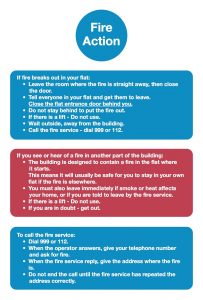Your building has been designed and built with fire safety in mind.
Living in a high-rise building doesn’t mean you are any more at risk from fire. It is important for your own safety, to understand what to do in the event of a fire, whether it’s in your flat, or somewhere else in the building.
You need to consider your fire safety and the impact you could have on other residents.
Make sure you know your buildings evacuation plan, this will include if the building has a Stay safe/stay put or Evacuation strategy.
Stay safe/stay put strategy
The building is designed to contain a fire in the flat where it started. This usually means:
- only those in the flat where the fire has started or
- those Flats affected by smoke or heat leave or
- if you are directed to by the Fire Service.
Evacuation strategy
This usually means everyone in the building immediately leaves when alerted by the alarm.
What to do if there is a fire

In your flat:
- leave the room where the fire is straight away, then close the door
- tell everyone in your flat and get them to leave
- close the flat entrance door behind you
- do not stay behind to put the fire out
- if there is a lift – do not use it
- wait outside, away from the building
- call the fire service – dial 999 or 112.
In another part of the building:
- the building is designed to contain a fire in the flat where it starts – this means it will usually be safe for you to stay in your own flat if the fire is elsewhere
- you must also leave immediately if the smoke or heat affects your home, or if you are told to leave by the fire service
- if there is a lift – do not use it
- if you are in doubt – get out.
If you can see the Fire Service on the ground, then there is no need to call 999. If every resident in a high-rise block rang 999, our control room wouldn’t be able to respond to other emergencies. Don’t be alarmed by the scale of the Fire Service’s presence. We need a large number of people to get our equipment from the ground up to the floor of the fire and to protect our firefighters.
Emergency access
Never block emergency access to your building, we need to get as close as possible to the entrance.
Protect your home
- Fit at least one smoke alarm in your flat.
- Fit a heat alarm in your kitchen and nothing in your bathroom due to false alarms.
- Test your alarms once a week.
- Never take the batteries out.
- Always follow the manufacturer’s advice.
Be prepared
- Keep all exits clear, both in communal corridors and in your home.
- Keep door and window keys near the exit.
- Prepare a grab bag that you can take if you need to be evacuated. Think about prescriptions, documents such as your driving licence and passport, spare keys, a mobile phone, charger and a torch.
- Know how to isolate your gas, electric and water supply.
- Get to know your neighbours. Are they young, elderly or vulnerable? They may need assistance in an emergency.
Firefighter equipment
Dry or wet riser pipes run internally through the block and are usually painted red. The Fire pipes provide water for the Fire Service to extinguish or prevent a fire from spreading.